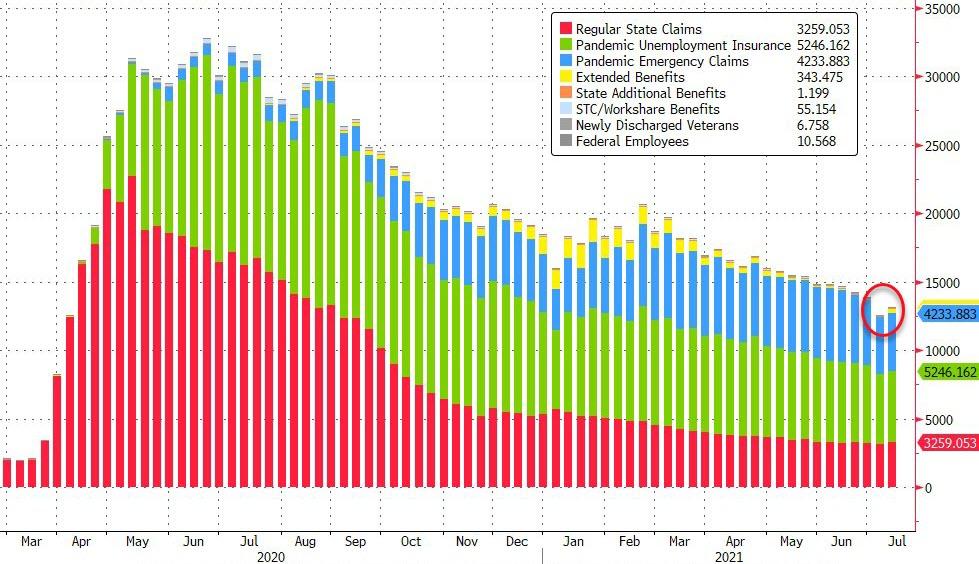- US GDP growth rate disappoints
- Initial claims fell less than anticipated
The US economy advanced an annualized 6.5% on quarter in Q2 2021, well below market forecasts of 8.5%, and just barely higher than Q1's 6.4%, the advance estimate showed. Personal consumption expenditures grew 11.8% namely services (12%) and nondurable goods (12.6%) as vaccinated Americans travel and engage in activities that were restricted before. Nonresidential fixed investment (8%), exports (6%), and state and local government spending (0.8%) also increased. Meanwhile, the negative contributions came from private inventory investment, residential fixed investment (-9.8%), federal government spending (-10.4%) and imports (7.8%). The rapid spread of the coronavirus delta variant, supply-chain disruptions, shortage of workers and a cooling housing market are seen weighing on the growth for the rest of the year, according to the U.S. Bureau of Economic Analysis
 The pace of GDP growth reported by the Commerce Department on Thursday was slower than economists had expected. Source: Bloomberg via ZeroHedge
The pace of GDP growth reported by the Commerce Department on Thursday was slower than economists had expected. Source: Bloomberg via ZeroHedge
The main reason for today's weak reading was the unexpected drop in inventories, which shrank -1.13% on expectations of an increase. Second reason was the inflation/PCE data, which showed that the GDP price index surged to 6% in the second quarter after increasing to 4.3% prior quarter, and surpassing analysts’ expectations of 5.4%, while core PCE q/q rose to 6.1% in the last quarter after increasing 2.7% in the Q1. This subtracted a further 0.6% from the annualized GDP print.
Summarizing, the GDP growth rate turned out to be much weaker than expected, but still 6.5% growth is significant. Today's report concluded positively on two counts. Personal consumption far exceeded market expectations as households continued to drain that $ 2.5 trillion in excess savings. On the other hand, a decline in inventories means that retailers will have to replenish their inventories in the near future, which should positively impact the next GDP reading.
A separate report from the Labor Department on Thursday showed initial claims for state unemployment benefits fell by 24k to a seasonally adjusted 400k but above market expectations of 380k. Claims are still far from the 200k level reported back in February 2020 despite record job openings and stepped-up attempts by many businesses to add staff. Also the number of Americans on some form of government dole disappointingly rose again.
 The total number of people receiving some kind of unemployment benefit returned above 13 million. Source: Bloomberg via ZeroHedge
The total number of people receiving some kind of unemployment benefit returned above 13 million. Source: Bloomberg via ZeroHedge
Many analysts expect this number to decline in the coming weeks due to the early phase-out of federal enhanced unemployment benefits in many states ahead of the official expiry date in September.
Today's data fits well with the FED narrative. Chair Powell made clear that further “substantial progress” required for tapering is towards maximum employment - not about inflation. If the labor market situation does not start to improve significantly in the coming months, then FED will have an excuse to uphold its current approach for longer even if other data points to a potential overheating of the economy.
BREAKING: European Services PMIs Slightly Above Expectations in October. EURUSD slightly up!
BREAKING: France's industrial production exceeds expectations! EURUSD slightly up!
Economic calendar: Key Macroeconomic Data from Europe and the US in Focus for Markets (05.11.2025)
BREAKING: Industrial orders from Germany slightly above expectations
This content has been created by XTB S.A. This service is provided by XTB S.A., with its registered office in Warsaw, at Prosta 67, 00-838 Warsaw, Poland, entered in the register of entrepreneurs of the National Court Register (Krajowy Rejestr Sądowy) conducted by District Court for the Capital City of Warsaw, XII Commercial Division of the National Court Register under KRS number 0000217580, REGON number 015803782 and Tax Identification Number (NIP) 527-24-43-955, with the fully paid up share capital in the amount of PLN 5.869.181,75. XTB S.A. conducts brokerage activities on the basis of the license granted by Polish Securities and Exchange Commission on 8th November 2005 No. DDM-M-4021-57-1/2005 and is supervised by Polish Supervision Authority.


